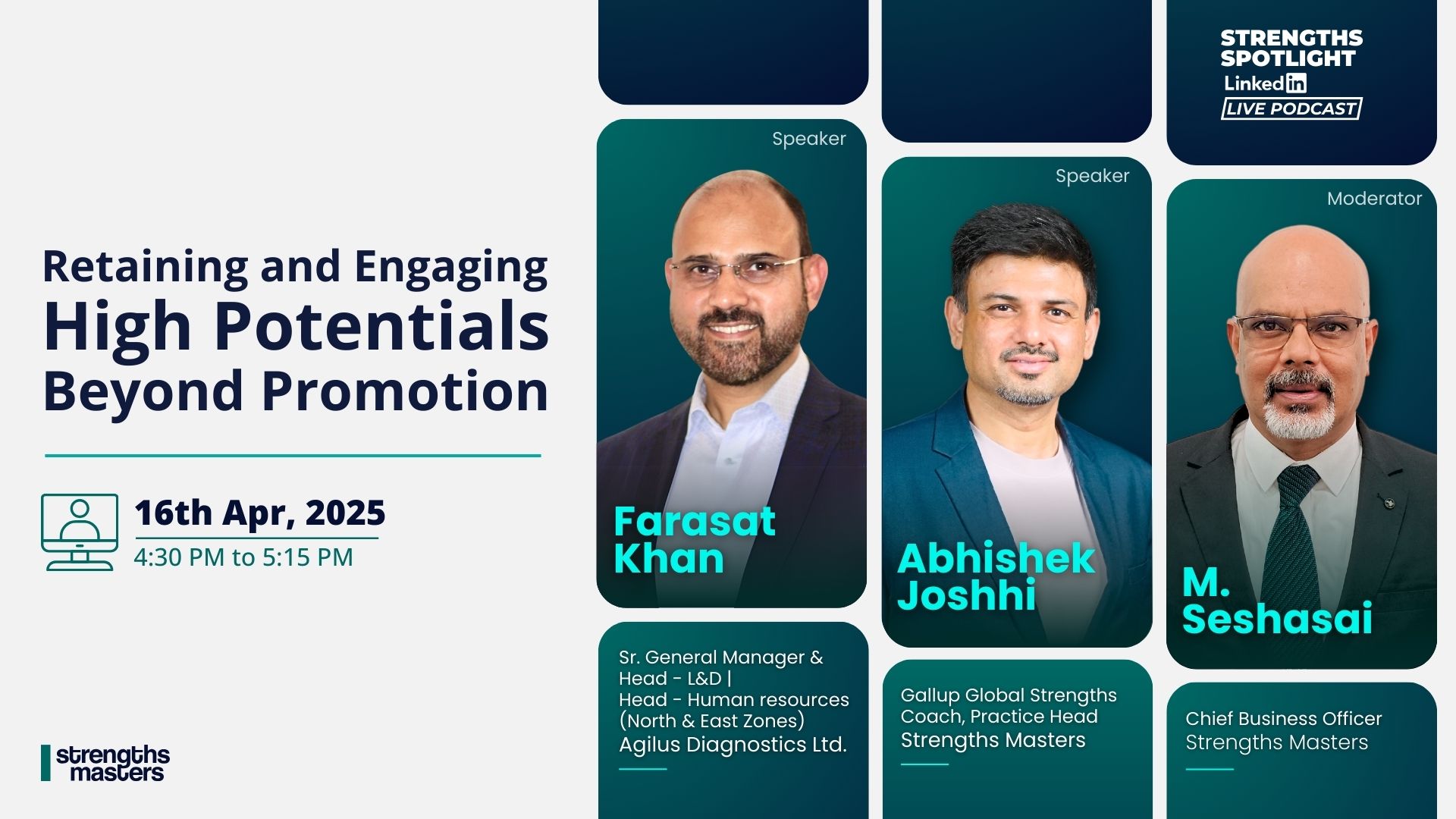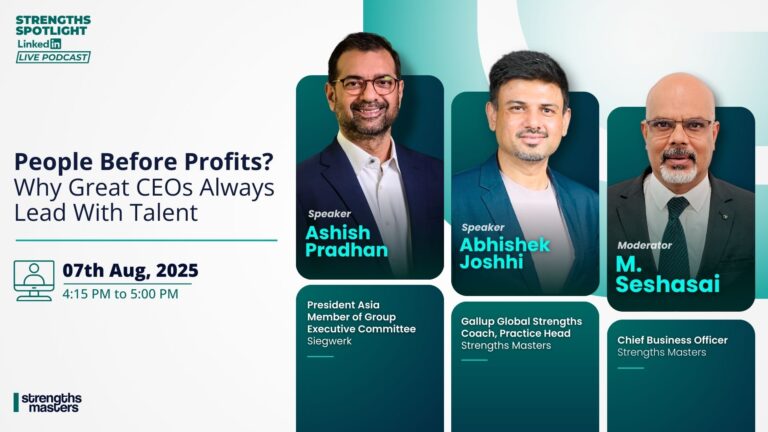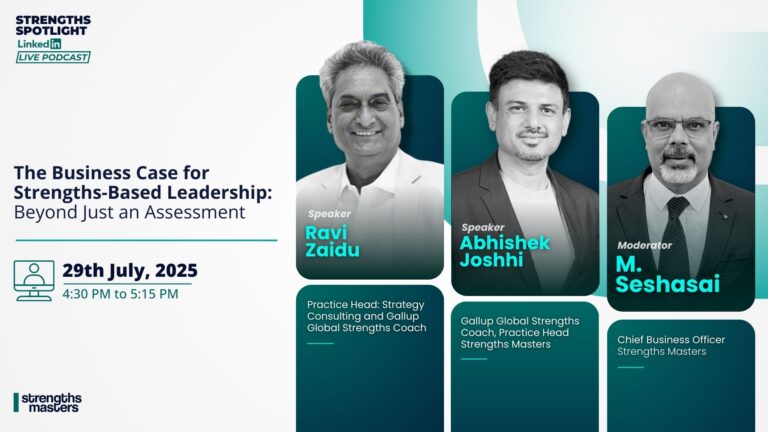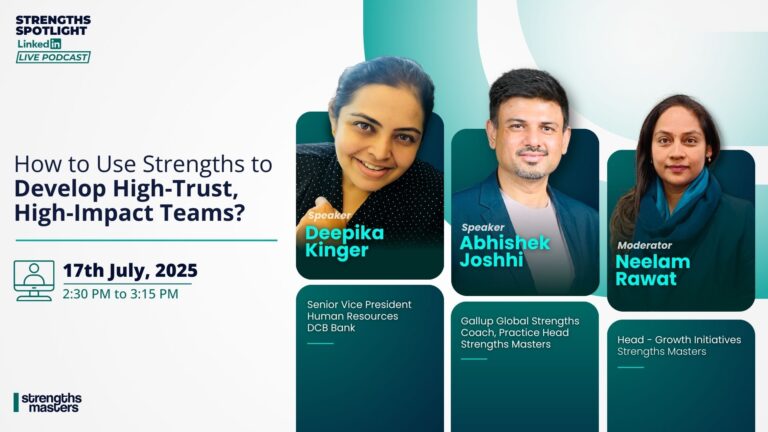Promotions are often seen as the ultimate reward for high performance, but are they enough to retain and engage high-potential talent in today’s dynamic workplaces?
In a candid and insightful episode of the Strengths Spotlight podcast, moderated by Seshasai, with guests Farasat Khan, Sr. General Manager & Head of L&D and HR (North & East Zones) at Agilus Diagnostics, and Abhishek Joshhi, Gallup-Certified Strengths Coach, the conversation revolved around a critical challenge facing organizations today: how to keep high-potential employees engaged, motivated, and growing, beyond the traditional promotion track.
This dialogue unearthed the subtle signals high-potentials send, why many companies fall short in retaining them, and what a strengths-based approach can do to create a deeper sense of purpose and commitment.
Meet Farasat Khan
With over 28 years of experience across industries and domains, Farasat Khan has worn many hats, from leading frontline sales teams to building learning strategies for large-scale organizations. Today, he serves as the Senior General Manager and Head of L&D and HR for the North & East Zones at Agilus Diagnostics.
Farasat is known for designing impactful learning journeys rooted in the principles of adult learning. Over the years, he has touched the lives of 25,000+ professionals through leadership interventions, change management programs, and behavioural development workshops.
But what truly sets him apart is his ability to see beyond the surface, to identify the deeper drivers of motivation, performance, and disengagement.
Understanding the High Potential Dilemma
The discussion began with a fundamental question: Who exactly are high potentials, and what makes them different from high performers?
Farasat offered a nuanced take. “A high performer may be someone who consistently achieves results in their current role, but a high potential is someone who not only delivers today but has the capability and aspiration to take on more complex roles tomorrow,” he explained.
He noted that organizations often blur the lines between the two. As a result, they either over-promote high performers who aren’t ready for leadership or underutilize high potentials, leading to disengagement and attrition.
He pointed out that traditional HR frameworks often reduce development to linear paths, one-size-fits-all programs, standard growth metrics, and periodic appraisals. “But high potentials don’t always want faster promotions. They want meaning, challenge, recognition, and the freedom to grow in ways that feel authentic to them.”
Invisible Signals and Subtle Disengagement
One of the most intriguing parts of the conversation revolved around how high-potentials begin to disengage quietly.
“They don’t slam the door on the way out. The decline is silent. They stop offering ideas. They don’t challenge the system anymore. They do what’s asked, but nothing more. That’s the first sign, and most organizations miss it,” said Farasat.
He talked about the importance of “being watchful”, not in a punitive or monitoring sense, but in terms of emotional attentiveness. Leaders must be attuned to the behavioral cues of their team members, when their eyes stop lighting up, when they start withdrawing from discussions, or when their once-vibrant curiosity turns into mechanical compliance.
This is especially tricky in remote and hybrid setups, where casual observation is limited. This is why, Farasat emphasized, conversations matter more than ever.
“It’s not about having a development plan reviewed every six months. It’s about having a real, strengths-based conversation every few weeks, what’s lighting you up, what’s bothering you, what’s next?”
Why Promotions Are No Longer Enough
A key theme was the shifting psychology of today’s workforce. Both Farasat and Abhishek agreed that while promotions and pay hikes are still appreciated, they’re no longer the primary currency of engagement for many high-potentials.
Farasat explained, “The need for belonging, autonomy, and contribution to something larger is much more powerful than the lure of a designation.” He shared how some of the most promising talent he has worked with didn’t want to be promoted, they wanted to go deeper into their craft, work on meaningful projects, or mentor others.
He also highlighted how job crafting, horizontal growth, and role enrichment are underutilized tools in many organizations. “Sometimes, the answer isn’t ‘up’, it’s ‘around.’ Give them stretch assignments, cross-functional exposure, or a chance to create something new.”
Abhishek added, “When you use a strengths-based lens, you stop seeing people through just a performance appraisal. You start seeing their natural wiring, their motivations, and how to build roles around what they do best.”
Five Key Lessons from the Conversation
Here are five powerful takeaways that organizations and leaders can apply:
1. Differentiate Between High Performers and High Potentials
Not every high performer wants, or is ready, for leadership. And not every high potential is the top performer today. It’s important to identify high-potentials based on traits like learning agility, aspiration, emotional intelligence, and problem-solving, not just current output.
2. Spot the Signs of Disengagement Early
High-potentials often don’t vocalize dissatisfaction. They quietly disengage. Leaders need to observe shifts in energy, participation, and initiative, and open up safe spaces for honest dialogue before it’s too late.
3. Move Beyond Promotions as the Sole Reward
Career progression doesn’t always mean climbing the ladder. Consider lateral moves, project ownership, internal gigs, mentorship opportunities, or space to innovate. Design careers around what energizes your high-potentials, not just titles.
4. Build a Culture of Frequent, Strengths-Based Conversations
Annual appraisals won’t cut it. Leaders should be having frequent, strength-focused check-ins to help employees reflect, recalibrate, and re-engage. Ask them, “Are you doing what you do best every day?”
5. Involve High Potentials in Business-Critical Projects
Nothing engages high-potentials more than knowing they’re making a real impact. Give them access to key business challenges, senior stakeholders, and opportunities to influence the organization’s direction, not just operations.
Final Thoughts: The Role of the Manager
As the episode came to a close, Farasat delivered a powerful message: “The manager is the bridge between talent and the organization’s purpose. And if that bridge is weak, even the best potential will fall through.”
He emphasized that while systems and frameworks are necessary, the human element cannot be overlooked. It is the manager’s behavior, availability, and mindset that either fuels or frustrates potential.
Abhishek echoed this sentiment, saying, “If we want to keep our best people, we need to make the conversation about them, their aspirations, their gifts, their story, not just the company’s agenda.”
They also touched on the danger of overlooking Gen Z expectations. Today’s young talent, Farasat noted, wants clarity, challenge, and connection. They’re not waiting around for annual feedback or generic training modules. They want growth, now, and they want it personalized.
Conclusion
Retaining and engaging high-potential employees is no longer about offering bigger salaries or corner offices. It’s about tapping into their purpose, understanding what excites them, and creating experiences that allow them to thrive.
This episode of Strengths Spotlight served as a timely reminder that the future of talent development lies not in promotions, but in personalization, purpose, and partnership.
As Farasat Khan so aptly put it, “It’s not about climbing ladders anymore. It’s about building ladders that fit the people climbing them.”
[Note: The views expressed by the speaker are their own and do not represent those of their organization.]





